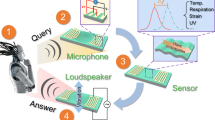Abstract
Eye fatigue has attracted significant interest due to its potential harm to human daily activities. An ultrathin flexible piezoelectric sensor was currently designed and fabricated to detect eye fatigue by deforming together with the eyelid epidermis. Herein we develop a theoretical model to illustrate the correlation between the eyelid motion and the signals output by the piezoelectric sensor. The theoretical predictions on the eyelid motion based on the measured electrical output agree well with the in vivo observations in experiment. A simple scaling law is established to evaluate the impacts of different parameters on the function ability of the flexible piezoelectric sensor. The results may provide useful guidelines for designing and optimizing similar devices for alike biological motions.
Similar content being viewed by others
References
Connor J, Norton R, Ameratunga S, et al. Driver sleepiness and risk of serious injury to car occupants: population based case control study. BMJ, 2002, 324: 1125
Huang J, Wang Y, Fu Z Y, et al. Fatigue among clinicians and the safety of patients. Chinese Medical Ethics, 2008, 347: 1249–1255
Lal S K L, Craig A. A critical review of the psychophysiology of driver fatigue. Biol Psychol, 2001, 55: 173–194
Saito S. Does fatigue exist in a quantitative measurement of eye movements? Ergonomics, 1992, 35: 607–615
Wu J D, Chen T R. Development of a drowsiness warning system based on the fuzzy logic images analysis. Expert Syst Appl, 2008, 34: 1556–1561
Dinges D F, Grace R. Perclos: a valid psychophysiological measure of alertness as assessed by psychomotor vigilance. Tech Brief, 1998, 35: 607–615
Divjak M, Bischof H. Eye blink based fatigue detection for prevention of computer vision syndrome. In: Proceedings of Conference on Machine Vision Application, Yokohama, 2009. 350–353
Zhang Z T, Zhang J S. A new real-time eye tracking for driver fatigue detection. In: Proceedings of the 6th International Conference on Telecommunications, Chengdu, 2006. 8–11
Ji Q, Zhu Z, Lan P. Real-time nonintrusive monitoring and prediction of driver fatigue. IEEE Trans Veh Technol, 2004, 53: 1052–1068
Martirosyan N, Kalani M Y. Epidermal electronics. Science, 2011, 333: 485–486
Wang S D, Li M, Wu J, et al. Mechanics of epidermal electronics. J Appl Mech, 2012, 79: 031022
Yeo W H, Kim Y S, Lee J, et al. Multifunctional epidermal electronics printed directly onto the skin. Adv Mater, 2013, 25: 2773–2778
Lu C F, Wu S, Lu B W, et al. Ultrathin exible piezoelectric sensors for monitoring eye fatigue. J Micromech Microeng, 2018, 28: 2
Jiang H, Khang D Y, Song J, et al. Finite deformation mechanics in buckled thin films on compliant supports. Proc Natl Acad Sci USA, 2007, 104: 15607–15612
Jiang H, Sun Y, Rogers J A, et al. Mechanics of precisely controlled thin film buckling on elastomeric substrate. Appl Phys Lett, 2007, 90: 133119
Zhang Y Y, Chen Y S, Lu B W, et al. Electromechanical modeling of energy harvesting from the motion of left ventricle in closed chest environment. J Appl Mech, 2016, 83: 061007
Ding H J, Chen W Q. 3 dimensional problems of piezoelasticity. Nova Biomed, 2001, 532
Lente M H, Eiras J A. Interrelationship between self-heating and ferroelectric properties in PZT ceramics during polarization reorientation. J Phys-Condens Matter, 2000, 12: 5939–5950
Mitchell J A, Reddy J N. A refined hybrid plate theory for composite laminates with piezoelectric laminae. Int J Solids Struct, 1995, 32: 2345–2367
Agache P G, Monneur C, Leveque J L, et al. Mechanical properties and Young’s modulus of human skin in vivo. Arch Dermatol Res, 1980, 269: 221–232
Takema Y, Yorimoto Y, Kawai M, et al. Age-related changes in the elastic properties and thickness of human facial skin. Br J Dermatol, 1994, 131: 641–648
Eriksson M, Papanikolopoulos N P. Driver fatigue: a vision-based approach to automatic diagnosis. Transpation Res Part C-Emerg Technol, 2001, 9: 399–413
Schmidtke K, Büttner-ennever J A. Nervous control of eyelid function. Brain, 1992, 115: 227–247
von Cramon D, Schuri U. Blink frequency and speech motor activity. Neuropsychologia, 1980, 18: 603–606
Evinger C, Manning K A, Sibony P A. Eyelid movements. mechanisms and normal data. Invest Ophth Vis Sci, 1991, 32: 387–400
Acknowledgements
This work was supported by National Natural Science Foundation of China (Grant Nos. 11322216, 11621062).
Author information
Authors and Affiliations
Corresponding author
Rights and permissions
About this article
Cite this article
Lu, C., Wu, S., Zhang, Y. et al. Electromechanical modeling of eye fatigue detecting using flexible piezoelectric sensors. Sci. China Inf. Sci. 61, 060417 (2018). https://doi.org/10.1007/s11432-018-9397-0
Received:
Revised:
Accepted:
Published:
DOI: https://doi.org/10.1007/s11432-018-9397-0




